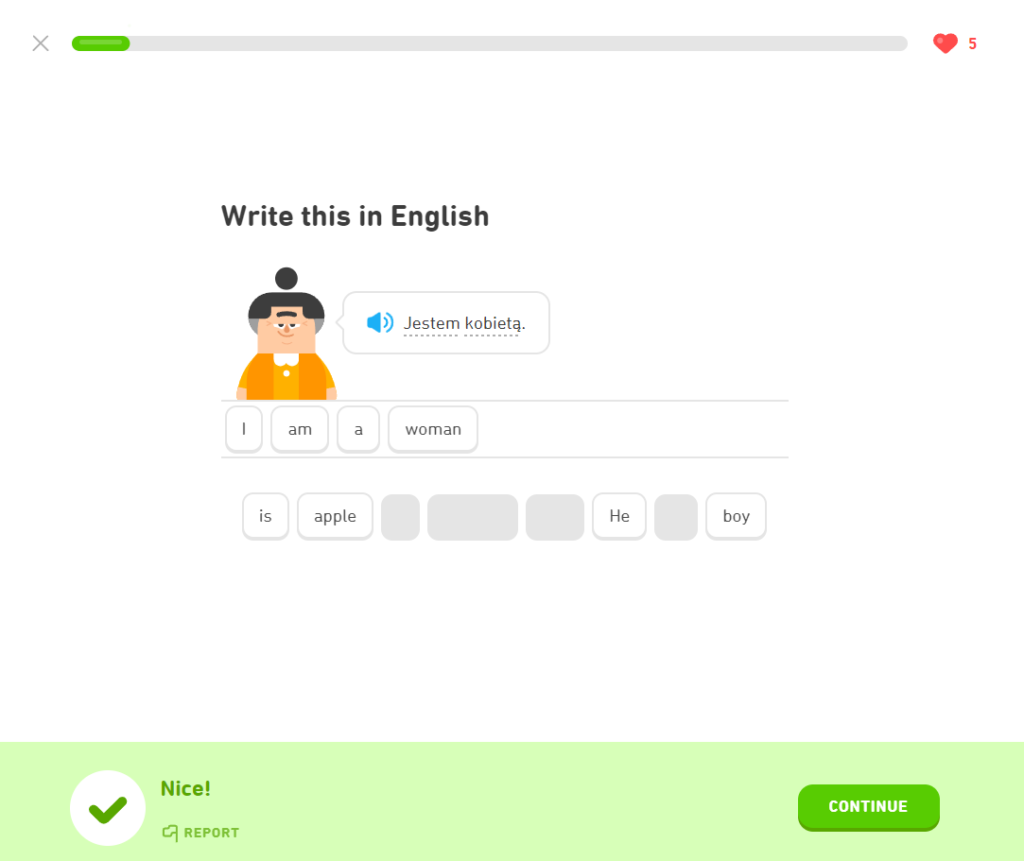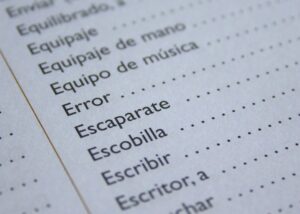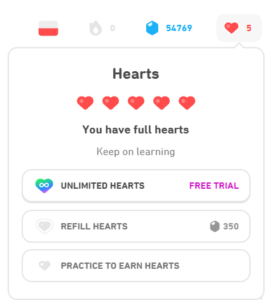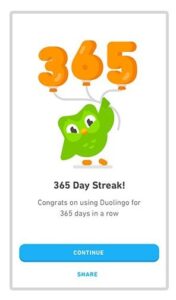Duolingo is a popular and well-known language-learning tool. It is often the first stop for learning a language, is it actually the best way to learn a language? This post will discuss some of the benefits that come from using Duolingo as well as how effective it is for teaching speaking skills – the one skill that is difficult to authentically learn from an app.
Duolingo has bite-sized language learning lessons which is vital for helping language learners continue lessons day after day. Learning a language is a journey that takes dedication and continued practice. The gamified learning of Duolingo’s lessons makes it easy to continue learning. The lessons also make sure that you feel successful in your learning after each lesson.

What Duolingo Does Well
In short, if you are starting to learn a language, whether it’s your first or 5th language, Duolingo will help get you off the ground.
One of the ways it does this is by starting you off nice and slow with some fairly simple words. It will do this for pretty much any language you are learning, so you can be sure to be learning words such as “hello”, “apple”, “bread”, “man” and “woman” pretty early in your learning journey. This is a good thing because it is consistent and expected. You know what you will be learning and the rough order it will be in.
This also means that you can supplement what you are learning on Duolingo with other learning apps as you desire.

Starting with common words like this also has another benefit. These are all common words that you can be sure to use in everyday conversations in any language. As a learner, you don’t want to start with words that seem irrelevant, so it is nice to start with something simple and straight forward such as these words.

Do I Need Duolingo Premium To Learn A Language?
Although Duolingo is free, it also comes with a premium version, called Super Duolingo, that can be paid for via a subscription. The cost is about $6.99 US per month (about $84 US for a year), as of 2023.
Depending on how much you use Duolingo, there may be some substantial benefits to having Super Duolingo for you.
Keep in mind that whether you buy a subscription or not, you will have access to the same learning material and languages that are offered by Duolingo.
The greatest benefit is the idea of having unlimited Hearts. These hearts are essentially your ‘health’ for each day. Each time you get an answer wrong, you lose a heart. While the hearts do refill at a rate of about one every five hours, it can mean that your practice is cut short if you make too many mistakes too quickly.

Another advantage of Super Duolingo is that there are no ads when using the app. Depending on how touchy you are about seeing ads when using a language-learning app, you may decide that this alone is worth the cost.
On the subject of cost, Duolingo does offer what is known as the family plan. This is Super Duolingo for up to six people for a cost of $9.99 US per month ($119.99 for a year). There are certain groups of people on forums such as Reddit who often post about getting together to create a family plan subscription to reduce the costs for all involved. This can help in making super Duolingo more cost-effective if you are interested in going down that path, though of course, it would be less risky to simply encourage friends and family to start a language learning journey with you.
I do not use a subscription for Duolingo, as I believe I am capable of learning a language without this particular subscription. I do however continue to use Duolingo, particularly in the early stages of language learning as it is a very useful tool.

Will Duolingo Help My Speaking?
One of the biggest questions about Duolingo is whether or not it will be effective in helping your speaking skills in your target language. I would suggest that Duolingo is probably not the most effective method of learning a language, specifically the speaking part of it. The reason I say this is because there is limited feedback that can be given in terms of authentic guidance, particularly when compared to native speakers.
There are certainly sections in the lessons that ask you to speak phrases or words. The biggest problem with this is that if you are anything like me, you are using Duolingo in public places, such as public transport, or food courts while on a lunch break. This then makes it a little bit uncomfortable to engage in these speaking sections of the lessons. The app may not hear my pronunciation because I am in a loud environment as well.
Thankfully the voice sections of the lessons can be skipped, however, this leaves me with the issue of not having practiced any speaking.
The best and easiest way to get around this is to speak to native speakers. I have a post about using native speakers that can be found here. However, what I do want to say about this, is that not everybody has the confidence time, or money to speak with a native speaker.
Obviously, the best-case scenario is that you are living with or are close friends with somebody who speaks your target language. Many of us can only dream of having somebody so close with whom to practice the language.
Another method I do want to suggest is quite new and still coming up. This is using an AI bot of some description to practice the language with. Similarly to practicing Duolingo as well as language tutors, there is still the possibility of issues with voice quality when using AI chatbots. There are however some benefits to this as well, such as much reduced costs, availability when you wish, and the potential for the chatbot to speak at your skill level.
There will be more information that is discussed about how to go about doing this shortly.

How To Best Use Duolingo
The best and most effective way to use Duolingo is to aim for a consistent routine. Whether you are using Duolingo on your daily commute or as part of your downtime when you are at home, keep a consistent time and place to do Duolingo.
If at all possible, try to have some sort of study partner. Whether this is a friend who is also interested in learning a language, or simply somebody that you are accountable to, having somebody who knows what you are doing and can ask you about it will help ensure that you maintain your schedule.
Within the app, you can also set personalized language learning goals. If you are a goal-orientated person, you may find this to be quite useful in helping keep you focused. There are also streak scores that will tell you how many days in a row you have used Duolingo. This can be quite motivational to see how many days in a row you can go. There are also streak freezes available so that if you do happen to miss a day, you don’t lose your streak.

Duolingo itself is a gamified language learning app, which will also help you to stay on schedule. I also recommend that you use other language learning, such as Anki, once you have a solid foundation for using Duolingo. Anki is a flashcard app that you can use to learn specific words that you are finding tricky, however, it will also let you create your own cards so you can start learning words that you are interested in.
Between Anki and Duolingo, your skills as a beginner language learner will quickly increase which should create a positive spiral of success that creates motivation to continue learning.

Summary Of Duolingo
Although some might see Duolingo as an over-glorified, gamified learning app that costs a lot for a subscription, it still has a place in the world. Language learning will continue to exist, and having a free, easy-to-access app such as this is a boon for everyone.
That is not to say that there are some issues within the app itself, such as the steep learning curve when learning a new script, but in general, Duolingo allows people a great taster for getting into language learning.
- Should Everyone In The World Speak A Universal Language?

- The Power of Immersing Yourself In A Language For Learning

- Start Your Language Learning Journey: Duolingo And Other Methods

- Does Learning A Language Help You Learn How Others Think

- Can You Learn a Language Without Learning Its Culture?

- Unlock Fluent Expression: Sentence Builders Across Languages

- Hidden Gems: Underrated Duolingo Languages Worth Learning

- The Ultimate German Pronunciation Guide

- Where To After Finishing Duolingo For Language Learning










